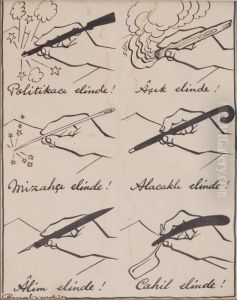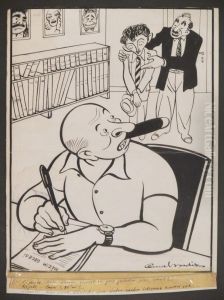Cemal Nadir Guler Paintings
Cemal Nadir Güler, born in 1902 in Bursa, Ottoman Empire, is a celebrated figure in Turkish art, particularly known for his contributions to the world of cartoons and illustration. His career began in the early 1920s, a period that saw the transition from the Ottoman Empire to the modern Republic of Turkey, an era marked by significant political, social, and cultural transformations. Cemal Nadir's work is often seen as a reflection of these changes, capturing the essence of Turkish society during a time of profound evolution.
After completing his education in Bursa, he moved to Istanbul, where he initially worked in various jobs unrelated to art. However, his passion for drawing and illustration soon led him to pursue a career in cartooning. In 1922, he started working as a cartoonist for the magazine Diken (Thorn), marking the beginning of his professional journey in the art world. Over the years, Cemal Nadir developed a distinctive style characterized by humor, satire, and social commentary, which quickly garnered him widespread popularity.
Throughout the 1920s and 1930s, he contributed to several magazines and newspapers, including Akbaba, one of Turkey's most prominent satirical magazines at the time. His work not only entertained but also provided critical commentary on the political and social issues of the day, making him a significant figure in the intellectual and cultural life of early Republican Turkey.
Cemal Nadir's legacy extends beyond his cartoons. He is credited with creating some of the first Turkish comic strips and is considered a pioneer in this genre. His characters and stories, full of wit and humor, have left a lasting impact on Turkish popular culture. Among his most famous creations is Amcabey, a character that appeared in various publications and became a household name in Turkey.
Tragically, Cemal Nadir Güler's life was cut short when he died in 1947 at the age of 45. Despite his relatively brief career, his influence on Turkish art and cartooning is profound. He paved the way for future generations of cartoonists and remains a beloved figure in Turkey's cultural history. His work continues to be celebrated for its innovation, humor, and insightful commentary on society and politics.

